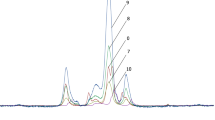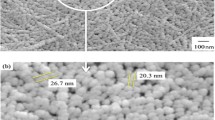Abstract
Chemical modification of cellulose by phosphorylation enhances its bioactivity and provides new derivatives and materials with specific end uses. In the present study, cellulose derivatized with phosphorous acid was obtained using the reaction of microcrystalline cellulose with phosphorous acid–urea mixture, in molten state, in comparison with others methods that used different solvents and catalysts. Completely water soluble films with a substitution degree close to one were obtained and characterized by analytical and spectral analysis (FT-IR, 31P NMR), contact angle, metallographic microscopy and atomic force microscopy (AFM). 31P NMR spectra of derivatized cellulose showed a signal at 2.58 ppm (assigned to P–O–C6) while the doublets at 4.99–5.29 and at 7.38 ppm were assigned to P–O–C2 and P–O–C3, respectively; thus, the formation of monosubstituted phosphorous acid esters of cellulose is advocated. Contact angle measurements showed that the work of adhesion is more important in water than in ethylene glycol, for the phosphorous acid derivatized cellulose. The cytocompatibility of this hydrosoluble derivatized cellulose was tested by direct contact and also by indirect assays on normal human dermal fibroblasts and on osteoblast-like cells (human osteosarcoma). Cell growth on phosphorylated cellulose pellicle and the results from viability assays had shown a good cytocompatibility and lack of toxicity. Phosphorous acid derivatized cellulose would offer a promising biomaterial, useful as scaffolds for new biopolymer composites, and subject for further development as an ionic crosslinker.








Similar content being viewed by others
References
Enderle JD, Blanchard SM, Bronzino JD. Introduction to biomedical engineering. San Diego: Academic Press; 2000.
Kennedy JF, Phillips GO, Williams PA, Cellucon Conferences (Organization), Sen’i Gakkai (Japan). Cellulose : structural and functional aspects. Ellis Horwood series in polymer science and technology. Chichester/New York: Ellis Horwood/Halsted Press; 1989.
Märtson M, Viljanto J, Hurme T, Laippala P, Saukko P. Is cellulose sponge degradable or stable as implantation material? An in vivo subcutaneous study in the rat. Biomaterials. 1999;20(21):1989–95. doi:10.1016/s0142-9612(99)00094-0.
Granja PL, De Jeso B, Bareille R, Rouais F, Baquey C, Barbosa MA. Mineralization of regenerated cellulose hydrogels induced by human bone marrow stromal cells. Eur Cell Mater. 2005;10:31–7; discussion 7–9.
Barbosa MA, Granja PL, Barrias CC, Amaral IF. Polysaccharides as scaffolds for bone regeneration. ITBM-RBM. 2005;26(3):212–7. doi:10.1016/j.rbmret.2005.04.006.
Barbié C, Chauveaux D, Barthe X, Baquey C, Poustis J. Biological behaviour of cellulosic materials after bone implantation: preliminary results. Clin Mater. 1990;5(2–4):251–8. doi:10.1016/0267-6605(90)90023-o.
Granja PL, Pouységu L, Pétraud M, De Jéso B, Baquey C, Barbosa MA. Cellulose phosphates as biomaterials. I. Synthesis and characterization of highly phosphorylated cellulose gels. J Appl Polym Sci. 2001;82(13):3341–53. doi:10.1002/app.2193.
Granja PL, Pouységu L, Deffieux D, Daudé G, De Jéso B, Labrugère C, et al. Cellulose phosphates as biomaterials. II. Surface chemical modification of regenerated cellulose hydrogels. J Appl Polym Sci. 2001;82(13):3354–65. doi:10.1002/app.2194.
Fricain JC, Granja PL, Barbosa MA, de Jéso B, Barthe N, Baquey C. Cellulose phosphates as biomaterials. In vivo biocompatibility studies. Biomaterials. 2002;23(4):971–80. doi:10.1016/s0142-9612(01)00152-1.
Granja PL, Barbosa MA, Pouységu L, De Jéso B, Rouais F, Baquey C. Cellulose phosphates as biomaterials. Mineralization of chemically modified regenerated cellulose hydrogels. J Mater Sci. 2001;36(9):2163–72. doi:10.1023/a:1017587815583.
Granja PL, Ribeiro CC, De Jeso B, Baquey C, Barbosa MA. Mineralization of regenerated cellulose hydrogels. J Mater Sci Mater Med. 2001;12(9):785–91.
Mucalo MR, Kato K, Yokogawa Y. Phosphorylated, cellulose-based substrates as potential adsorbents for bone morphogenetic proteins in biomedical applications: a protein adsorption screening study using cytochrome C as a bone morphogenetic protein mimic. Colloids Surf B. 2009;71(1):52–8. doi:10.1016/j.colsurfb.2009.01.004.
Kim SS, Jeong WY, Shin BC, Oh SY, Kim HW, Rhee JM. Behavior of CHO cells on phosphated cellulose membranes. J Biomed Mater Res. 1998;40(3):401–6.
Nifant’ev EE. The Phosphorylation of Cellulose. Russ Chem Rev. 1965;34(12):942–9. doi:10.1070/RC1965v034n12ABEH001577.
McCormick CL, Callais PA, Hutchinson BH. Solution studies of cellulose in lithium chloride and N,N-dimethylacetamide. Macromolecules. 1985;18(12):2394–401. doi:10.1021/ma00154a010.
Ramos LA, Assaf JM, El Seoud OA, Frollini E. Influence of the supramolecular structure and physicochemical properties of cellulose on its dissolution in a lithium chloride/N,N-Dimethylacetamide solvent system. Biomacromolecules. 2005;6(5):2638–47. doi:10.1021/bm0400776.
Isogai A, Atalla RH. Dissolution of cellulose in aqueous NaOH solutions. Cellulose. 1998;5(4):309–19. doi:10.1023/a:1009272632367.
Petreuş O, Bubulac T, Petreuş I, Cazacu G. Reactions of some phosphorus compounds with cellulose dissolved in aqueous alkaline solution. J Appl Polym Sci. 2003;90(2):327–33. doi:10.1002/app.12532.
Inagaki N, Nakamura S, Asai H, Katsuura K. Phosphorylation of cellulose with phosphorous acid and thermal degradation of the product. J Appl Polym Sci. 1976;20(10):2829–36. doi:10.1002/app.1976.070201017.
Gospodinova N, Grelard A, Jeannin M, Chitanu GC, Carpov A, Thiery V, et al. Efficient solvent-free microwave phosphorylation of microcrystalline cellulose. Green Chem. 2002;4(3):220–2.
Inagaki N, Katsuura K. Modification of cellulose phosphonate with N, N-dimethylacrylamide and 4-vinylpyridine, and flame-retardant properties of the products. J Polym Sci. 1978;16(11):2771–9. doi:10.1002/pol.1978.170161105.
Luneva N, Petrovskaya L, Ezovitova T. Synthesis and properties of cellulose phosphates. Russ J Appl Chem. 2007;80(11):1923–7. doi:10.1134/s1070427207110298.
Weil ED, Levchik SV. Flame retardants for plastics and textiles: practical applications. Cincinnati: Hanser; 2009.
Suflet DM, Chitanu GC, Popa VI. Phosphorylation of polysaccharides: new results on synthesis and characterisation of phosphorylated cellulose. React Funct Polym. 2006;66(11):1240–9. doi:10.1016/j.reactfunctpolym.2006.03.006.
Granja PL, Jéso BD, Bareille R, Rouais F, Baquey C, Barbosa MA. Cellulose phosphates as biomaterials. In vitro biocompatibility studies. React Funct Polym. 2006;66(7):728–39. doi:10.1016/j.reactfunctpolym.2005.10.027.
Petreuş O, Cazacu G, Vasile C, Bubulac T. Noi metode de sinteză a celulozei fosforilate şi utilizarea sa ca biomaterial. Celuloză şi Hârtie. 2003;52(20):20–6.
Simionescu C, Butnaru R, Rozmarin G. Investigation the field of the supermolecular structure of cellulose. Cellulose Chem Technol. 1973;7:153–69.
Pimentel GC, Sederholm CH. Correlation of infrared stretching frequencies and hydrogen bond distances in crystals. J Chem Phys. 1956;24(4):639. doi:10.1063/1.1742588.
Rozmarin G, Simionescu C, Bulacovschi V, Butnaru R. Chimia lemnului si a celulozei. Iasi: Litografia Institutului Politehnic; 1973. p. 175–93.
Merz W. Eine mikroanalytische schnellmethode zur bestimmung von phosphor sowie zur gleichzeitigen bestimmung von phosphor und halogen in organischen substanzen. Microchim Acta. 1959;47(3):456–65. doi:10.1007/bf01216866.
Mosmann T. Rapid colorimetric assay for cellular growth and survival: application to proliferation and cytotoxicity assays. J Immunol Methods. 1983;65(1–2):55–63. doi:10.1016/0022-1759(83)90303-4.
Cory AH, Owen TC, Barltrop JA, Cory JG. Use of an aqueous soluble tetrazolium/formazan assay for cell growth assays in culture. Cancer Commun. 1991;3(7):207–12.
Suzuki M, Yoshida T, Koyama T, Kobayashi S, Kimura M, Hanabusa K, et al. Ionic conduction in partially phosphorylated poly(vinyl alcohol) as polymer electrolytes. Polymer. 2000;41(12):4531–6. doi:10.1016/s0032-3861(99)00682-5.
Granja P, Pouysegu L, Petraud M, De Jeso B, Baquey C, Barbosa M. Cellulose phosphates as biomaterials. I. Synthesis and characterization of highly phosphorylated cellulose gels. J Appl Polym Sci. 2001;82(13):3341–53.
Curtis A, Forrester J, Clark P. Substrate hydroxylation and cell adhesion. J Cell Sci. 1986;86(1):9–24.
Kim S, Jeong W, Shin B, Oh S, Kim H, Rhee J. Behavior of CHO cells on phosphated cellulose membranes. J Biomed Mater Res. 1998;40(3):401–6.
Popescu C, Tibirna C, Raschip I, Popescu M, Ander P, Vasile C. Bulk and surface characterization of unbleached and bleaced softwood kraft pulp fibers. Cellulose Chem Technol. 2008;42(9–10):525–7.
Bismarck A, Kumru ME, Springer J. Characterization of several polymer surfaces by streaming potential and wetting measurements: some reflections on acid–base interactions. J Colloid Interface Sci. 1999;217(2):377–87. doi:10.1006/jcis 1999.6345.
Yamane C, Aoyagi T, Ago M, Sato K, Okajima K, Takahashi T. Two different surface properties of regenerated cellulose due to structural anisotropy. Polymer. 2006;38(8):819–26.
De Bartolo L, Morelli S, Bader A, Drioli E. Evaluation of cell behaviour related to physico-chemical properties of polymeric membranes to be used in bioartificial organs. Biomaterials. 2002;23(12):2485–97. doi:10.1016/s0142-9612(01)00383-0.
Gunnars S, Wågberg L. Cohen stuart MA. model films of cellulose:I. Method development and initial results. Cellulose. 2002;9(3):239–49. doi:10.1023/a:1021196914398.
Kolovith L, Ingall E, Benner R. Composition and cycling of marine organic phosphorus. Limnol Oceanogr. 2001;46(2):309–20.
Maciel GE, Kolodziejski WL, Bertran MS, Dale BE. Carbon-13 NMR and order in cellulose. Macromolecules. 1982;15(2):686–7. doi:10.1021/ma00230a097.
Segal L, Creely JJ, Martin AE, Conrad CM. An empirical method for estimating the degree of crystallinity of native cellulose using the X-ray diffractometer. Text Res J. 1959;29(10):786–94. doi:10.1177/004051755902901003.
Rathna GV. Gelatin hydrogels: enhanced biocompatibility, drug release and cell viability. J Mater Sci Mater Med. 2008;19(6):2351–8. doi:10.1007/s10856-007-3334-9.
Acknowledgments
This paper was supported by the Research Grant IDEI 2560/2008.
Author information
Authors and Affiliations
Corresponding author
Rights and permissions
About this article
Cite this article
Petreus, T., Stoica, B.A., Petreus, O. et al. Preparation and cytocompatibility evaluation for hydrosoluble phosphorous acid-derivatized cellulose as tissue engineering scaffold material. J Mater Sci: Mater Med 25, 1115–1127 (2014). https://doi.org/10.1007/s10856-014-5146-z
Received:
Accepted:
Published:
Issue Date:
DOI: https://doi.org/10.1007/s10856-014-5146-z




